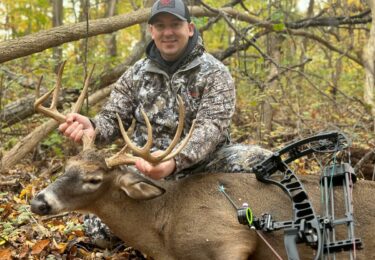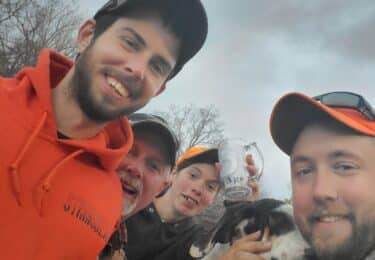Eastern Coyote Hunting
Kyle Backenstoes
You sit down along the field edge, and wait for things to settle down. You hear the whistle of the wind through the
surrounding trees. You grip your call and let out the first squall of a rabbit in distress. Your heart races in anticipation.
5 minutes go by. 10 minutes. You begin to wonder if its going to happen. 15 minutes, and a coyote steps out of the woods
into the field. Your heart begins to race and adrenalin flows through your body, you settle your crosshairs and squeeze
the trigger. When the shot clears you realize you’ve just succeeded in harvesting an eastern coyote! This is a challenge
not many hunters seem to realize. However it is a great way to keep your hunting senses in balance during the off season.
Coyote hunting will also help your deer, and turkey populations as well. The eastern coyote is very similar to the western
coyote. Most do not realize this due to the higher density of cover in the east. Most coyote activity and hunting is done
at night, and does not present most hunters with a good hunting opportunity. Follow these tips and tactics and it will help
you put more fur down this year!
Calling
There are many different types of predator calls on the market. So many that it can be confusing to the beginning predator
hunter. There are many types of different coyote vocalizations. However these types of calls will work best in the coyote
mating season. In the east, this period is generally mid winter. This is similar to the whitetail rut, males will be
territorial and will respond well to challenge howls and female vocalizations. There are also distress calls. These calls
will work year round. A coyote needs to eat like any other animal, and when there is a “free meal” coyotes will respond
very well. So which type of animal distress do i chose? This is a very commonly asked question with a very simple answer!
You need to match your calls with the abundant food source in your area. For example, if you area has a high concentration
of field mice, you want to chose a field mouse distress. If you are unsure, a cottontail rabbit is a great place to start,
due to higher population numbers across America. You have the basics on the types of calls, now what kind of calls do you
chose? Electric or a hand call? There are certain advantages and disadvantages to both. An electric call will put the
attention of the animal on the caller, and not on the hunter. It also gives you a strict advantage to hunt the wind. Most
times there calls come with multiple sounds pre loaded onto the caller! There are also certain types of disadvantages to
these types of calls. These calls are generally more expensive. Another disadvantage is the inability to quickly change
volume and adjust tones of the call as you seem fit. Hand calls are cheaper than electric callers. They also give you the
ability to change tone, volume, and attitude of the call very quickly based on the animals reaction to the call. These
types of calls will cause more movement by the hunter, therefore increasing the chances to get busted by the animal. These
calls will also attract the animals attention directly to the caller. Most have different preferences, and rightfully so.
You as a hunter need to know what works best for you, and your area.
Camouflage
This is an extremely important part of coyote hunting. Especially in the east. Most coyotes that are called in the east are
in closer proximity to the hunter therefore giving them a greater ability to pick out threats. An eastern coyote hunter needs
head to toe camouflage. Keep in mind that a coyote is a predator and knows his home turf like you know your house. This is
where he lives and he has the ability to pick out any changes. With this being said you need an affective camo pattern that
will work for your area. In most areas of the east a good woodland pattern will work. A highly recommended pattern would be
Sitka Gears, optifade forest. In areas with a more open environment, Sitka Gear has a optifade open country pattern that is
extremely affective.
Scent Control
Coyotes has a great sense of smell. The combined ability of all their senses makes them an extremely affective predator. A
coyotes nose is very affective. A coyote can wind a human at over 500 yards away. A coyote will almost always circle downwind
of the caller before coming to investigate. A hunter has to be extremely cautious about scent control. If you are looking
to get a definite edge on them with scent control, a great thing to check out is the Xterminator. This is an electronic
scent control device. This will greatly reduce a coyotes ability to smell you! Other thing that should be looked at are
cover scents. Hunters should use cover scents as a way to control scent. Coyote urine works best, however any natural scent
will do.
Other Common Tactics
A very common mistake made is time spent on stand. In some cases coyotes will come in very quickly to your call, this is
rarely the case. Most coyotes will take time to circle downwind before acting. This often takes time. A hunter should spend
at least 30 minutes in a given calling location, sometimes even more time is necessary. Another helpful thing to keep in
mind while out hunting is the ability to set up and call often. In dense and thick cover, your calls will not travel as far.
Coyote populations in the east are far more spread out than the west making it important to setup and call as often as
possible. The more stands you make, the more chances you have to call in a coyote! Another important part of the coyote
hunting mix is a decoy. While it is not necessary, it is a very helpful part of calling, as it will take all the attention
off of the hunter and onto the decoy.
These are just a few very basic tips to help you get started in coyote hunting. Hunting predators will not only get rid
cabin fever in the off season, it will also help your local deer and turkey populations. With states like Pennsylvania
putting bounties on these animals, what’s not to like? Go grab a few calls, a gun, and go call in some coyotes!!
-Cervicide Field Staff Kyle Backenstoes


